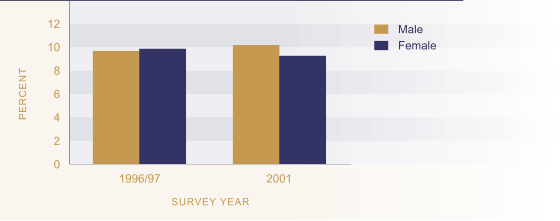Relevance
The 'disability requiring assistance' prevalence rate is an important summary measure of non-fatal health outcomes.
Current Level and Trends
In 2001, the age standardised prevalence rate of disability requiring assistance was 10.2 percent for males and 9.3 percent for females. This rate has barely changed since 1996/1997, when it was 9.7 percent for males and 9.9 percent for females.
Figure H3.1 Disability requiring
assistance prevalence rate by sex, 1996/97, 2001

Source: Statistics New
Zealand /Ministry of Health
Note: Age-standardised to the WHO world population
Most people who have disabilities requiring assistance need only intermittent help. In 2001, 7.8 percent of males and 7.0 percent of females had this moderate level of disability. A further 2.4 percent of males and 2.3 percent of females had a more severe level of disability requiring daily help.
Sex Differences
On an age-standardised basis, the prevalence of disability requiring assistance is marginally higher among males than among females. However, because rates of disability requiring assistance are higher among older age groups, where women predominate, the majority of people with disability requiring assistance are women.
Ethnic Differences
Māori are more likely than non-Māori to have a functional disability requiring assistance. In 2001, the disability requiring assistance prevalence rate for males was 13.4 percent for Māori and 9.9 percent for non-Māori. Prevalence rates for females were 14.5 percent for Māori and 9 percent for non-Māori. There was almost no change in levels of disability requiring assistance for Māori from 1996-1997 to 2001.
Table H3.1 Disability requiring assistance prevalence rate, Māori, non-Māori, by level of functional disability, 2001
| Moderate | Severe | Total | |
|---|---|---|---|
| Māori males | 9.4 | 4.0 | 13.4 |
| Māori females | 9.9 | 4.6 | 14.5 |
| Non-Māori males | 7.6 | 2.3 | 9.9 |
| Non-Māori females | 6.8 | 2.2 | 9.0 |
| Total males | 7.8 | 2.4 | 10.2 |
| Total females | 7.0 | 2.3 | 9.3 |
Source: Ministry of Health
Note: Age-standardised to the WHO world population
Moderate = Requiring intermittent (ie non-daily) assistance
Severe = Requiring continuous or daily assistance, generally in the
self-care domain
International Comparison
The rate of disability requiring assistance in New Zealand appears to be higher than that reported in similar studies in Australia, Canada and the United States, although this may be influenced by differences in the collection and classification of data.15
